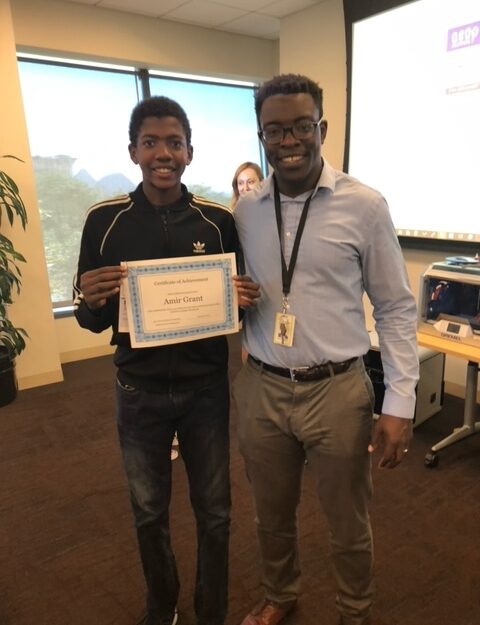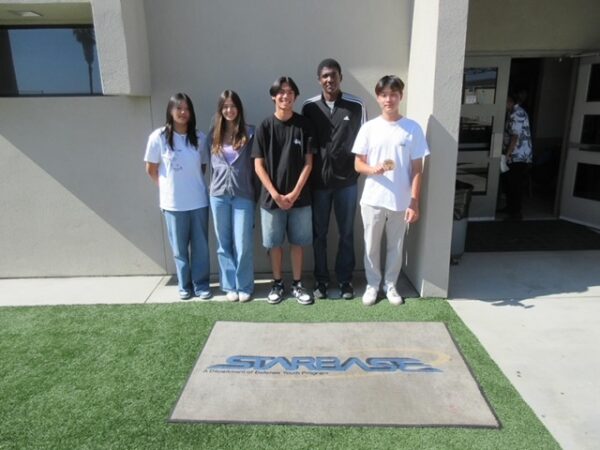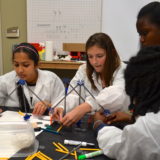August 23, 2024

Meet Amir Grant, who has been a key figure in the ARL Playa Vista GEMS program for the past six years! Based in Los Angeles, Amir is set to attend Lindenwood University in Missouri in the fall, where he will major in mechanical engineering while also playing Division 1 volleyball. Discover how his experience with GEMS – first as a student, then as a mentor – has shaped his STEM career and left a lasting impact.
How did you first get involved with AEOP?
My mom told me about GEMS when I was about to enter seventh grade. I was trying to figure out what I wanted to do, and I was eager to explore engineering and other STEM fields that interested me.
I decided to participate, and I really enjoyed it. I liked what they taught us and what I experienced, so I just kept coming back!
What did your six years with GEMS look like?
I spent four years as a student and two years as a mentor . As a student, there were a lot of presentations where professionals would share: “Here are these different jobs that I do, and here’s how I got them!” As I progressed into the program, there were a lot more interactive, hands-on activities.
During my fourth year as a student, we had a mechanical engineer present about systems; he talked about drones and automation. He had us participate in activities similar to how he would program and gather accurate information.
As a mentor, I helped plan these kinds of activities. I would also work to have a deeper knowledge of the subject at hand, so when the kids come in, I could help them understand it as well. I’m still friends with some other mentors!
I liked being able to come back after so many years and still be a part of the program, where I received valuable feedback about how I was doing and where I was heading in life. I was also able to ask for recommendation letters, and I really enjoyed the partnership with the program as a whole.
How did you pull on your experience as a student to help yourself in that mentorship role?
I was a shy kid growing up, so helping other shy kids come out of their shells became really important to me. Encouraging them to engage in activities and share their thoughts so they could get the most out of the program is what I value the most from my experience.
Do you have a favorite memory from the program?
My favorite memory was Steven Thurman’s presentation. I liked his eye tracking demonstration and the different activities he led. We discussed how eye tracking is used in different forms of media, including advertisements, and how he develops technology for it. I really enjoyed that presentation, and that always stood out to me!
We started off talking about the brain and how it works with eyesight; then we moved on to visual illusions and how those function. Then he brought in eye tracking; which is his area of focus. He showed us examples of advertisements – one with a baby looking at you, the viewer, and then another with a baby looking at some text. He had a heat graph, so where people will look is hotter, and where colder. We realized that when the baby was looking at the text, more viewers would read the text instead of looking at the baby. This is because people tend to follow where others are looking. Another example would be when people shout, “Oh, look! There’s a plane!” and they point up at the sky – most people will look too.
 How has GEMS helped you, either professionally or personally?
How has GEMS helped you, either professionally or personally?
Professionally, it helped me decide what field I wanted to major in college. Two years ago, my last year as a student, some visitors included an electrical engineer and a mechanical engineer. I knew I wanted to become an engineer, but I was always unsure about which field I wanted to go into. Being able to learn and speak with those presenters about what they do and what their jobs entailed helped me decide my career path.
I figured out that I wanted to work with building things, but I didn’t want to do construction necessarily. So I talked to a mechanical engineer. He told me that they work with a broad subject of things and you can go anywhere you want with it. I want to use that degree to have the freedom to pursue whatever path I choose after college.
GEMS also helped me with public speaking; I was a shy kid, and this opportunity allowed me to step up and become a leader and advocate for all my students.
What advice would you give other students seeking STEM opportunities like GEMS?
Don’t be shy. Don’t be afraid to reach out and ask questions. Try to be as involved as you can!
What’s next for you?
I am going to Lindenwood in the fall. After four years there, I want to transfer to Washington University and get my master’s in mechanical engineering. Plus, they have a great volleyball team!
I would like to design things on CAD. I like working with computers. So having a job where I could work on computers and design things is a goal.
To learn more about GEMS, click here.

Gains in the Education of Mathematics and Science (GEMS)
Gains in the Education of Mathematics and Science (GEMS) is an U.S. Army-sponsored, summer STEM enrichment program for middle and high school students that takes place in participating U.S. Army research laboratories and engineering centers.
More About Gains in the Education of Mathematics and Science (GEMS)Find a Volunteering Opportunity
Visit our Program Volunteers page for a tool to find the best opportunity for you.
eCYBERMISSION Mini-Grant
The eCYBERMISSION Mini-Grant is intended to support teachers/program leaders as they implement eCYBERMISSION with their teams. Educators (formal and informal) of students in grades 6-9 are encouraged to apply.
